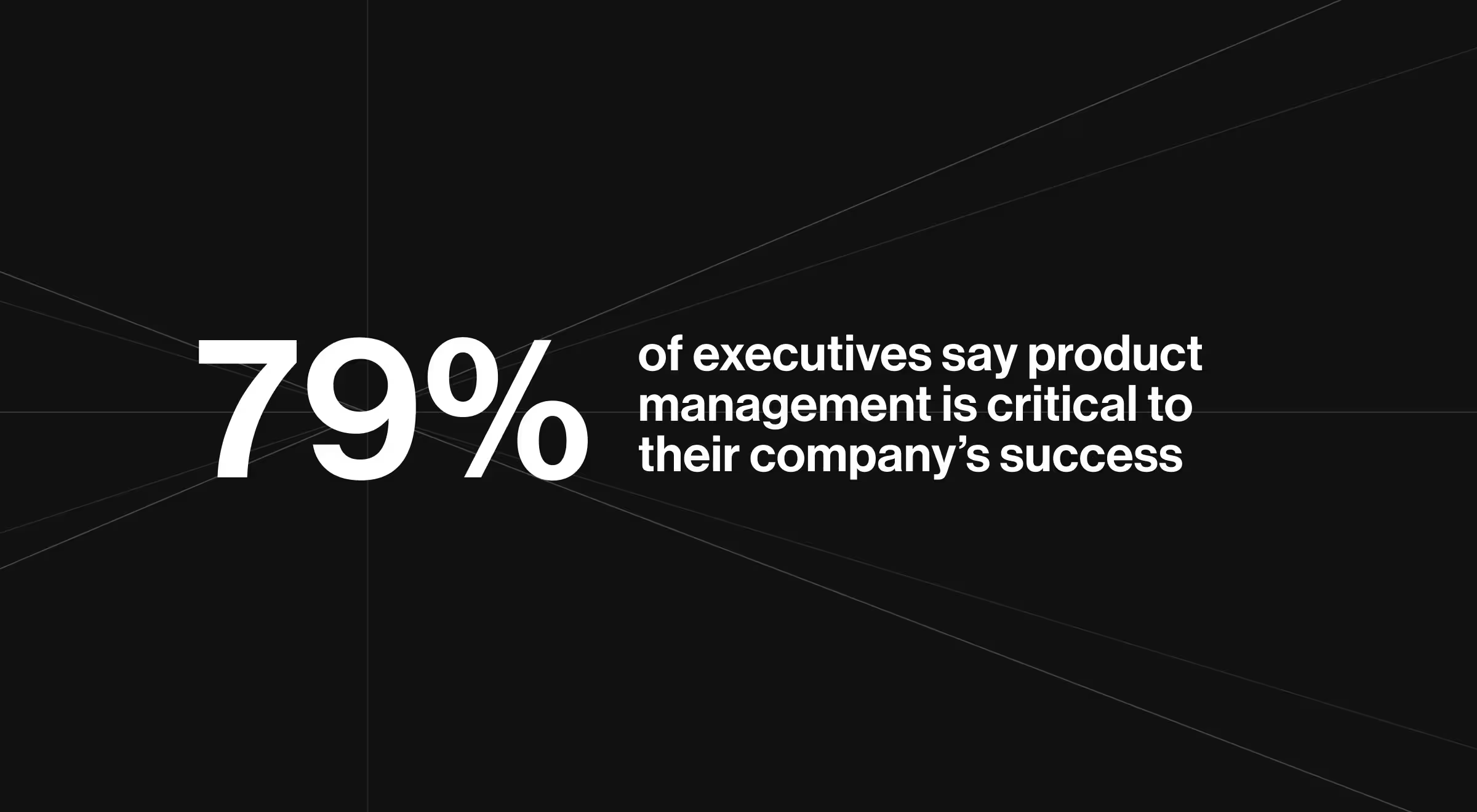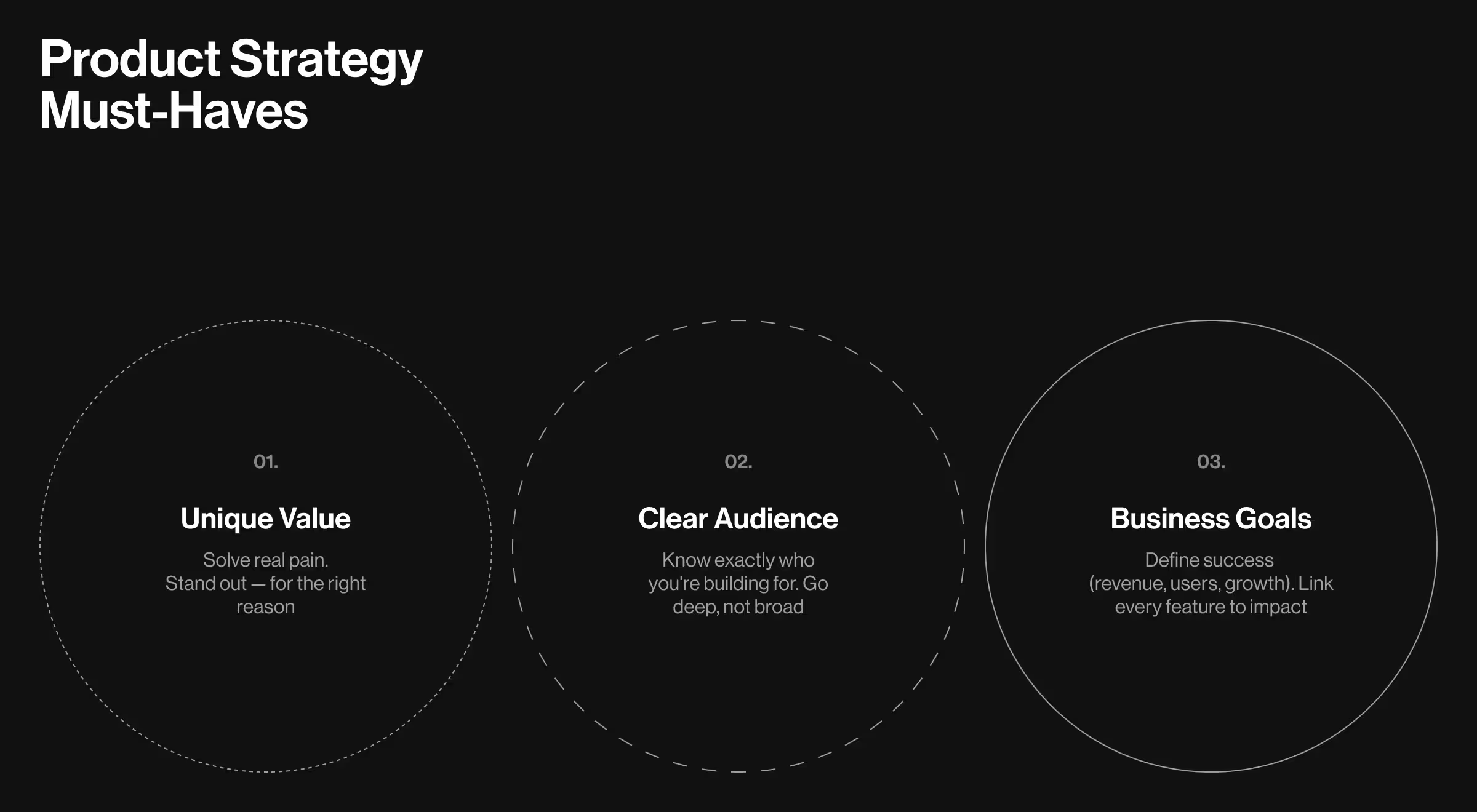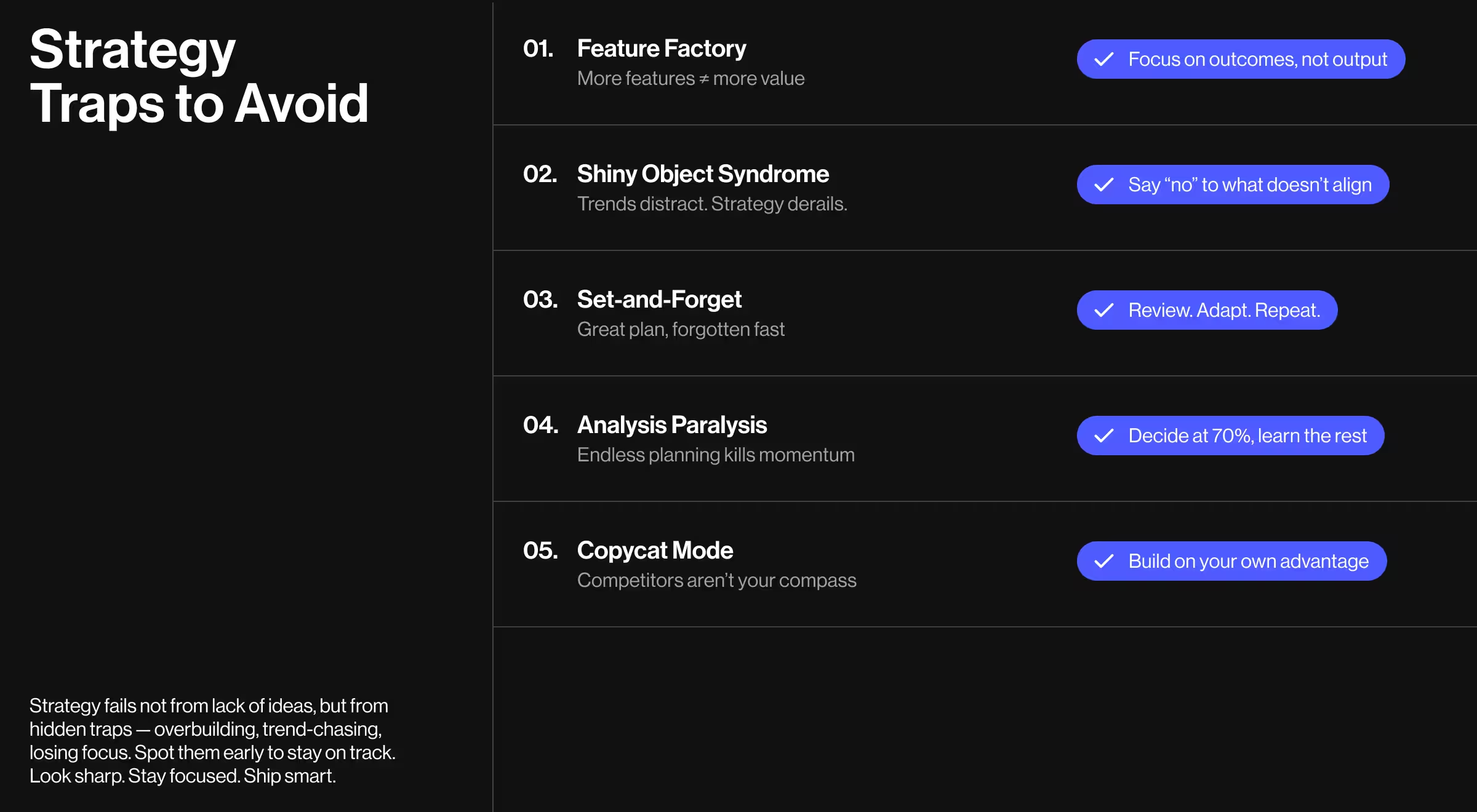Building a successful product is a lot like designing a house. It's not about adding flashy features or pouring money into marble floors. It's about laying a solid foundation, understanding who's going to live there (your users), and making sure every room serves a real purpose. Otherwise, you end up with a beautiful mess that no one actually wants to live in.
Key takeaways
- A well-defined product strategy framework aligns your entire team around a shared vision, preventing costly pivots and wasted resources.
- Successful product strategy combines deep market research with clear business objectives to identify the most valuable opportunities.
- The best product strategies focus on solving specific pain points for a defined target audience rather than trying to please everyone.
- Regular strategy reviews and customer feedback loops ensure your product stays relevant as market conditions evolve.
What makes a product strategy framework essential
According to Harvard Business School professor Clayton Christensen, there are over 30,000 new products introduced every year, and 95% of them fail. A product strategy framework can help you overcome these challenges and serve as the foundation that guides every product decision, from which features to build next to how you allocate resources effectively. When done right, it becomes the North Star that keeps your product team focused on what matters most.
To give you some stats, according to research by McKinsey, companies that lead with unique strategic positioning achieve 2.5x higher revenue growth than those that follow competitive responses.
Your product strategy defines the path from where you are today to where you want your product to be. It answers the fundamental questions that every product team faces: Who are we building for? What problem are we solving? How do we win in this market?

79% of executives say product management is critical to their company's success, yet many organizations still struggle with strategic clarity. A winning product strategy framework connects your product vision to your overall business objectives. It's not enough to build something users like – you need to build something that drives real business value while solving genuine customer needs.
The best product strategies start with thorough market research. You need to understand your target market inside and out. What are the current market trends? Who are your competitors? What gaps exist that your product could fill?
"Strategy is about making choices, trade-offs; it's about deliberately choosing to be different."
{{Oleksandr Golovko}}
Product strategy vs. other strategic documents
Before diving into frameworks, let's clarify what product strategy actually is and how it differs from related documents:
Product strategy vs. product roadmap
Product strategy defines the "why" and "what" – your vision, target users, value proposition, and competitive positioning. It's your high-level plan for achieving product success.
Product roadmap defines the "when" and "how" – it's a timeline of action items, features, and milestones that bring your strategy to life. Your roadmap should always flow from your strategy, not the other way around.
Product strategy vs. business model
Business model is the broader perspective on how your entire business operates, including all products, services, revenue streams, and operational structure.
Product strategy is a sub-component focused specifically on one product's path to success within that larger business ecosystem.
Quick reference checklist
✅ You need a product strategy when:
- Launching a new product or entering a new market.
- Experiencing declining growth or stagnating metrics.
- Facing increased competition or market disruption.
- Your team lacks clarity on priorities and direction.
- Strategic decisions feel arbitrary or opinion-based.
Which product strategy framework to choose?
Product strategy can feel overwhelming – so many frameworks, so little time! But you don’t need to use them all. You just need the right one for your product, team, and goals.
Let’s break down some of the most popular product strategy frameworks out there, then help you figure out how to actually use them in the real world.

Most popular product strategy frameworks (and why they work)
1. The product strategy pyramid
Think of this as your product’s DNA:
- Vision at the top (your big “why”)
- Goals in the middle (your measurable targets)
- Initiatives at the bottom (the features you’ll ship)
It’s great for aligning stakeholders and keeping teams focused.
2. The three horizons framework
This one helps you manage both short-term wins and long-term innovation:
- Horizon 1: Core improvements to today’s product
- Horizon 2: Emerging opportunities
- Horizon 3: Disruptive bets for the future
Perfect for scaling companies juggling multiple priorities.
3. Jobs to be done (JTBD)
Every feature must earn its place by helping the user get a job done. Ask: What “job” is the user hiring our product to do?
Use JTBD to uncover deeper user needs and design smarter solutions.
4. OKRs (objectives & key results)
Popular with product-led teams, OKRs keep strategy measurable and focused.
Set big-picture objectives, and tie them to key results that define success.
5. North Star framework
This one asks: What’s the one metric that reflects the value you deliver to users?
Your North Star Metric guides everything — from product decisions to team alignment.
Framework сomparison table
How to choose the right framework for your team
Don't pick a framework just because it's trendy. Choose one based on:
- Stage of your product: Startups often love the North Star or JTBD; growing orgs benefit from OKRs or Three Horizons
- Team size & structure: Small teams need simplicity. Bigger orgs need structure
- Your goals: Are you scaling? Improving UX? Breaking into new markets?
You can even mix and match. For example: use the Product Strategy Pyramid to define vision, then track goals with OKRs. It's not cheating if it gets results.
Framework selection decision tree
START HERE: What's your primary challenge?
"We need clearer direction and alignment" → Try: product strategy pyramid or North Star framework
"We're juggling too many priorities" → Try: three horizons framework or OKRs
"We don't understand our users deeply enough" → Try: jobs to be done or value proposition canvas
"We need to validate assumptions quickly" → Try: lean startup method
"We can't measure if we're succeeding" → Try: OKRs or North Star framework
A great framework is just a tool. The real magic comes from your team's insight, alignment, and willingness to iterate. Choose what feels right, test it in action, and don't be afraid to evolve.
The must-haves of every great product strategy

1. Define your unique value proposition
Your unique value proposition is what sets your product apart from everything else in the market. To succeed, you need more than uniqueness — you need to create real value for the people you're building for.
After all, 2% of shutdown business ventures that launched a new product failed to solve any good customer problem. This underscores the importance of problem-solution fit before product-market fit.
Start by analyzing your competitors. What solutions already exist? Where do they fall short? Your differentiation strategy should focus on the areas where you can deliver unique benefits that competitors can't easily replicate.
The strongest value propositions address specific pain points that your target users experience regularly. Generic solutions rarely win against focused ones that solve real problems exceptionally well.
A powerful value proposition typically follows this structure:
"We help [target customer] [achieve specific outcome] by [unique approach/feature] so they can [ultimate benefit]."
Example: "We help busy professionals stay fit by delivering personalized 15-minute workouts they can do anywhere, so they can maintain their health without sacrificing productivity."
2. Understand your target audience
A successful product strategy requires intimate knowledge of your target audience. You can't build for everyone, so you need to get crystal clear on who you're serving.
Create detailed user personas that go beyond basic demographics. What are their daily workflows? What frustrates them about current solutions? What would make their lives significantly easier?
Your target users should be specific enough that you can name companies or individuals who fit the profile. If your target audience feels too broad, narrow it down until you have a clear sense of exactly who would benefit most from your product.
"If you're not embarrassed by the first version of your product, you've launched too late." - Reid Hoffman, LinkedIn Founder
3. Set clear business goals
Your product strategy outlines how your product contributes to your company's mission and overarching business goals. Every product initiative should connect back to measurable business outcomes.
Define what product success looks like in concrete terms. Is it user acquisition? Revenue growth? Market share? Customer satisfaction scores? Having clear metrics helps your whole company stay on the same page about what you're trying to achieve.
Only 3% of new products sell for over $50 million in the first year. This statistic highlights the importance of setting realistic revenue expectations while building for long-term growth.
Building your product roadmap
Prioritize features that matter
Your product roadmap brings strategy to life. Start by focusing on features that deliver high value to users and support business goals. Not every feature request belongs.se customer feedback to validate ideas, but don’t let it dictate direction.
✅ Pro Tip: One great feature > ten mediocre ones. Quality wins.
Resource allocation & timeline planning
A strong strategy needs realistic planning. Balance ambition with available resources by breaking big initiatives into manageable pieces. This keeps momentum high and progress visible.
Also, weigh how new features fit your existing architecture, some require deep foundational work that users may not see but is essential.
🌟 Team insight: 41.2% say product management success depends on PM skill. Make sure strong leaders are at the helm.
Feature prioritization framework: RICE score
Calculate a RICE score for each potential feature:
- Reach: How many users will this impact? (per quarter)
- Impact: How much will it improve the experience? (0.25 = minimal, 3 = massive)
- Confidence: How certain are you? (% as decimal: 50% = 0.5)
- Effort: How many person-months will it take?
Formula: RICE Score = (Reach × Impact × Confidence) / Effort
Example:
- Feature reaches 5,000 users per quarter
- Impact score: 2 (high)
- Confidence: 80% (0.8)
- Effort: 3 person-months
- RICE Score = (5,000 × 2 × 0.8) / 3 = 2,667
Compare RICE scores across features to prioritize objectively.
Market research and competitive analysis
Analyze market trends and opportunities
Thorough market research forms the backbone of any successful product strategy. You need to understand not just where the market is today, but where it's heading.
Look for patterns in how similar products have evolved. Are there similar growth patterns across different companies in your space? What external factors are driving change in your industry?
Pay attention to broader market conditions that might affect your product's success. Economic shifts, regulatory changes, and technological advances can all create new opportunities or threats.
Understand customer needs and pain points
The best products solve problems that customers didn't even know they had. This requires going beyond what customers say they want to understand what they actually need.
Spend time observing how your target customers work today. What workarounds do they use? Where do they waste time? What causes them stress or frustration?
Customer interviews reveal explicit needs, but behavioral data shows implicit needs. Combine both approaches to get a complete picture of the opportunities available. Remember: Your most unhappy customers are your greatest source of learning.
Implementation and execution
Aligning cross-functional teams
Your strategy framework only works if everyone understands it and commits to it. This means getting your cross-functional team aligned around the same vision and priorities.
Regular strategy reviews help ensure everyone stays focused on the right goals. When market conditions change or new information emerges, update your strategy and communicate changes clearly to the whole team.
Create shared documents and dashboards that make your strategy visible to everyone. When team members can see how their work contributes to the bigger picture, they make better decisions independently.
Measuring success and iterating
A clear strategy includes clear success metrics. Define what good performance looks like for each aspect of your product strategy, from user satisfaction to business impact.
Track both leading and lagging indicators. User engagement metrics can predict future revenue trends, while retention rates show the long-term health of your product.
Be prepared to adjust your strategy based on what you learn. The best product strategies evolve as you gather more data about what works and what doesn't.
"The goal is to turn data into information, and information into insight."
{{Oleksandr Golovko}}
Go-to-Market Strategy Integration
How you plan to acquire customers should influence what you build and when you build it.
Consider how your target customers prefer to discover and evaluate new products. B2B customers might need extensive documentation and free trials, while consumer products might rely more on viral features and social proof.
Building for Scale and Growth
Think beyond your next quarter when planning your product strategy. What you build today should support your vision for where the product will be in two or three years.
Consider how your product architecture will handle growth. Can your current approach support 10x more users? What about 100x? Plan for success by thinking through how different growth scenarios would affect your product strategy.
Go-to-market strategy integration
How you plan to acquire customers should influence what you build and when you build it.
Consider how your target customers prefer to discover and evaluate new products. B2B customers might need extensive documentation and free trials, while consumer products might rely more on viral features and social proof.
Building for scale and growth
Think beyond your next quarter when planning your product strategy. What you build today should support your vision for where the product will be in two or three years.
Consider how your product architecture will handle growth. Can your current approach support 10x more users? What about 100x? Plan for success by thinking through how different growth scenarios would affect your product strategy.
Common Strategy Pitfalls to Avoid
Many product teams create strategies that look good on paper but fail in practice. Understanding these common mistakes can save your team months of wasted effort and help you avoid joining the 95% of products that fail to achieve their strategic objectives.

The feature factory trap
Teams fall into the "feature factory" mindset, believing that shipping more functionality equals strategic success. They measure progress by features delivered rather than customer problems solved or business value created. This leads to bloated products that confuse users and drain resources without moving key metrics.
How to solve it:
- Define clear outcome-based metrics for every strategic initiative
- Ask "What customer problem does this solve?" before adding any feature to your roadmap
- Implement regular strategy reviews that focus on business impact, not feature velocity
- Use frameworks like OKRs (Objectives and Key Results) to tie features to measurable outcomes
- Conduct user research to validate that new features actually improve the customer experience
Real example: Microsoft's Windows Vista packed in hundreds of new features but users found it bloated, slow, and confusing. Windows 7 succeeded by focusing on fewer features executed excellently.
The shiny object syndrome
Product teams get distracted by new market trends, competitor moves, or exciting partnership opportunities that don't align with their core strategy. This "shiny object syndrome" leads to scattered efforts, diluted value propositions, and confused customers who can't understand what the product actually does best.
How to solve it:
- Create a clear "strategy filter" – a set of criteria that new opportunities must meet before consideration
- Establish quarterly strategy reviews where you explicitly say "no" to attractive but misaligned opportunities
- Document your strategic trade-offs to remind the team why certain paths were rejected
- Use the "hell yes or no" principle – if an opportunity isn't clearly aligned with your strategy, it's a no
- Set aside dedicated time for strategic exploration separate from execution to avoid constant pivoting
Companies that maintain strategic focus are 60% more likely to achieve their growth targets compared to those that pursue multiple strategic directions simultaneously.
The set-and-forget strategy mistake
Teams create comprehensive strategy documents during planning cycles but fail to revisit or update them as circumstances change. Market shifts, competitive moves, and customer feedback accumulate while the team continues executing against an outdated strategic foundation, leading to misalignment and missed opportunities.
How to solve it:
- Schedule monthly strategy check-ins to review key assumptions and market conditions
- Create triggers for strategy review (new competitor, major customer feedback, market shifts)
- Use rolling quarterly planning that allows strategy adjustments while maintaining execution focus
- Assign someone to monitor external factors that could affect your strategic assumptions
- Document what you learn and how it impacts your strategic decisions
- Make strategy documents accessible and visible to keep them top-of-mind for daily decisions
The analysis paralysis trap
The problem: Some teams spend so much time researching, analyzing, and perfecting their strategy that they never actually execute. They become trapped in endless planning cycles, waiting for perfect information that never comes, while competitors move ahead with "good enough" strategies and real market feedback.
How to solve it:
- Set time-boxed strategy development periods (typically 4-6 weeks maximum)
- Use the 70% rule – make strategic decisions when you have 70% of the information you wish you had
- Build learning plans into your strategy that allow you to test assumptions quickly
- Focus on creating minimum viable strategies that you can iterate and improve
- Establish clear decision-making frameworks to avoid revisiting settled strategic questions
Real example: Google's approach is to "launch and iterate." Gmail launched as a beta and stayed there for 5 years while they continuously improved based on real user feedback.
The competitive copycat syndrome
The problem: Teams lose strategic confidence and start copying competitor moves instead of following their own strategic vision. This reactive approach leads to me-too products that lack differentiation and fail to capitalize on unique market opportunities.
How to solve it:
- Conduct competitive analysis to understand the market, not to dictate your strategy
- Focus on your unique value proposition and customer insights rather than competitor features
- Use competitive intelligence to identify market gaps and differentiation opportunities
- Create strategic principles that guide decision-making independent of competitor actions
- Regular strategy reviews should ask "Are we staying true to our vision?" not "What are competitors doing?"
Real example: Zoom didn't try to match all of Skype's or WebEx's features. They focused obsessively on reliability and simplicity, which became their differentiation and drove massive adoption.
Lazarev.agency's strategic product development excellence

Client Challenge:
Riptide held a respected position in the market, offering the coolest electric skateboards. The company managed to pack substantial power into a compact skate deck at an affordable price, all while being a promoter of freedom, street boldness, and serenity.
However, despite their market popularity, their website failed to showcase the skates in their full glory and posed challenges to online skate sales. As a result, they aimed to revamp their digital experience.
Approach:
The Riptide co-founders approached Lazarev.agency prior to a New Year's sale. Understanding the heightened competition during this period, our team recognized the need to craft a distinctive digital experience that would not only grab attention, but also ignite potential buyers' interest in purchasing the skateboards. Our strategic focus centered on effectively conveying the brand's core values through every digital touchpoint.
Our goal was ambitious: transform the e-commerce site to resonate with individuals on an emotional level, evoking feelings of freedom, speed, and serenity — going far beyond simply selling skateboards to selling a lifestyle and identity.
Results:
- $500K Revenue Impact: Within just 2 months after launching a redesigned digital experience, Riptide achieved a complete sell-out worth half a million dollars, a testament to the power of strategic digital product development.
- Strategic Business Exit: The success of our strategic digital transformation made Riptide an attractive acquisition target. After the successful sell-out, the founders were able to sell the company at a premium valuation, directly demonstrating how Lazarev.agency's work creates measurable business value.
- Market Leadership Achievement: Riptide got into the top 10 brands for skateboard sales in the U.S., transforming them from a respected market participant into a recognized market leader.
Partner with us to bring your vision to life
The best product strategies combine deep customer understanding with clear business objectives. They help teams prioritize ruthlessly and execute consistently. Most importantly, they evolve based on real market feedback and customer behavior.
Your product strategy should be specific enough to guide daily decisions but flexible enough to adapt as you learn. When your entire team understands the strategy and commits to it, you can create products that truly delight customers while achieving your business goals.
Ready to build a product strategy that drives real results with the best Bay Area web design agency? Our digital product design agency specializes in turning strategic vision into user-centered products that scale. Contact us to discuss how we can help transform your product idea into a winning strategy.





























.webp)



















